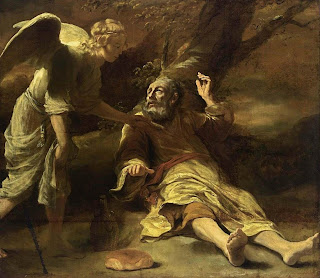The Mystical Meaning of the Prophet Elias, the Ash Bread, and the 40 Days
St Elias and the Ash Bread
Today at the College of Saint Thomas More in Fort Worth Texas, Father Juan Diego of the Franciscan Friars of the Renewal preached a homily about Saint Bonaventure’s spiritual interpretation of the 3 Kings 19:3-8.* The passage refers to Elias’ 40 day fast, which is a type of the 40 day fast of Christ our Lord and the corporate 40 day fast of the Catholic Church:
 “And he cast himself down, and slept in the shadow of the juniper tree: and behold an angel of the Lord touched him, and said to him: Arise and eat. He looked, and behold there was at his head a hearth cake, and a vessel of water: and he ate and drank, and he fell asleep again. And the angel of the Lord came again the second time, and touched him, and said to him: Arise, eat: for thou hast yet a great way to go. And he arose, and ate and drank, and walked in the strength of that food forty days and forty nights, unto the mount of God, Horeb.” (1 Kings 19:5–8, D-R)
“And he cast himself down, and slept in the shadow of the juniper tree: and behold an angel of the Lord touched him, and said to him: Arise and eat. He looked, and behold there was at his head a hearth cake, and a vessel of water: and he ate and drank, and he fell asleep again. And the angel of the Lord came again the second time, and touched him, and said to him: Arise, eat: for thou hast yet a great way to go. And he arose, and ate and drank, and walked in the strength of that food forty days and forty nights, unto the mount of God, Horeb.” (1 Kings 19:5–8, D-R)Father Juan Diego drew our attention to the Holy Spirit’s reference to the “hearth cake.” In Latin, it is called the “subcinericius panis.” The Latin “subcinericius” means “under ashes.” This was “bread cooked under ashes.” This corresponds exactly to the Hebrew עֻגַ֥ת רְצָפִ֖ים meaning “bread of coal” or “ember bread.”
The idea is that this bread was cooked under hot ashes. It’s outer layer is burned. One must rip away the ashen outside to find the wholesome bread within.
Saint Bonaventure teaches that just as the accidents of bread remain in the Holy Eucharist, the substance of Christ is within. By faith, we must not focus our eyes on the sensible accidents of bread, but must penetrate by faith into the substance of Christ that is present to us. The wholesome bread from Heaven is within. Just as the burned outer layer of the “ash bread” was stripped away with hands so that the inner substance could be received, so our faith rips away the accidents of bread and wine so that we can see the presence of Christ with the eyes of faith.
Moreover, the sign of “bread under ashes” is a reminder that Lent is essentially Eucharistic. As the Eucharistic victim for sinners, Christ bears the ashes of penance for the sake of our everlasting salvation. St Elias began his 40 days with the “bread under ashes” and this gave him the strength to endure for 40 days – on that mystical bread alone. So also, we gain our fortitude for Lent through the Holy Eucharist subcinericius panis.
Holy Elias, pray for us.
Saint Bonaventure, pray for us.
Do you enjoy reading Canterbury Tales by Taylor Marshall? Make it easier to receive daily posts. It’s free. Please click here to sign up by Feed or here to sign up by Email. Please also explore Taylor’s books about Catholicism at amazon.com.
*In the Latin Vulgate, 1&2 Samuel are 1&2 Kings, thereby making the next two books 3&4 Kings.
What to Watch Next
You have to choose the future for America. Is it a Christian Nation or a Demonic Nation?...
The perpetrator of Wednesday morning’s tragedy at a Catholic School reveals a hostile war against Christianity. Dr....
The Latin Catholic Patriarchate of Jerusalem and the Greek Orthodox Patriarchate have issued a joint press release...
SHOP THE TAYLOR MARSHALL STORE
Dive Deeper

GET CONFIDENT IN YOUR FAITH
Explore the fascinating world of Catholic teachings with Dr. Marshall. Together you’ll unpack the brilliant answers the Church gives to tough questions about the Faith. The best part: you go at your own pace. Start this exciting journey today.


 >
>




